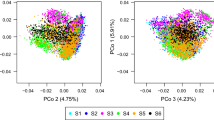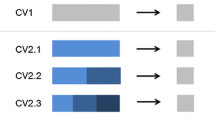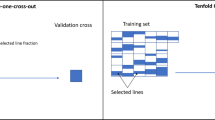Abstract
This is the first large-scale experimental study on genome-based prediction of testcross values in an advanced cycle breeding population of maize. The study comprised testcross progenies of 1,380 doubled haploid lines of maize derived from 36 crosses and phenotyped for grain yield and grain dry matter content in seven locations. The lines were genotyped with 1,152 single nucleotide polymorphism markers. Pedigree data were available for three generations. We used best linear unbiased prediction and stratified cross-validation to evaluate the performance of prediction models differing in the modeling of relatedness between inbred lines and in the calculation of genome-based coefficients of similarity. The choice of similarity coefficient did not affect prediction accuracies. Models including genomic information yielded significantly higher prediction accuracies than the model based on pedigree information alone. Average prediction accuracies based on genomic data were high even for a complex trait like grain yield (0.72–0.74) when the cross-validation scheme allowed for a high degree of relatedness between the estimation and the test set. When predictions were performed across distantly related families, prediction accuracies decreased significantly (0.47–0.48). Prediction accuracies decreased with decreasing sample size but were still high when the population size was halved (0.67–0.69). The results from this study are encouraging with respect to genome-based prediction of the genetic value of untested lines in advanced cycle breeding populations and the implementation of genomic selection in the breeding process.




Similar content being viewed by others
References
Akaike H (1974) A new look at the statistical model identification. IEEE Trans Auto Control 19:716–723
Bernardo R (1993) Estimation of coefficient of coancestry using molecular markers in maize. Theor Appl Genet 85:1055–1062
Bernardo R (2002) Breeding for quantitative traits in plants. Stemma Press, Woodbury, MN
Bernardo R, Yu J (2007) Prospects for genomewide selection for quantitative traits in maize. Crop Sci 47:1082–1090
Crossa J, de los Campos G, Pérez P, Gianola D, Burgueño J, Araus JL, Makumbi D, Singh RP, Dreisigacker S, Yan J, Arief V, Banzinger M, Braun HJ (2010) Prediction of genetic values of quantitative traits in plant breeding using pedigree and molecular markers. Genetics 186:713–724
Dekkers JCM (2007) Prediction of response to marker-assisted and genomic selection using selection index theory. J Anim Breed Genet 124:331–341
Foulkes AS (2009) Applied statistical genetics with R: for population-based association studies, 1st edn. Springer, New York
Gilmour AR, Gogel BJ, Cullis BR, Thompson R (2009) ASReml user guide release 3.0. VSN International Ltd. Hemel Hempstead
Goddard ME (2008) Genomic selection: prediction of accuracy and maximization of long term response. Genetica 136:245–257
Grubbs FE (1950) Sample criteria for testing outlying observations. Ann Math Stat 21:27–58
Habier D, Fernando RL, Dekkers JCM (2007) The impact of genetic relationship information on genome-assisted breeding values. Genetics 177:2389–2397
Habier D, Tetens J, Seefried FR, Lichtner P, Thaller G (2010) The impact of genetic relationship information on genomic breeding values in German Holstein cattle. Genet Sel Evol 42:5
Hayes BJ, Goddard ME (2008) Technical note: prediction of breeding values using marker-derived relationship matrices. J Anim Sci 86:2089–2092
Hayes BJ, Daetwyler HD, Bowman P, Moser G, Tier B, Crump R, Khatkar M, Raadsma HW, Goddard ME (2009a) Accuracy of genomic selection: comparing theory and results. Proc Assoc Adv Anim Breed Genet 18:34–37
Hayes BJ, Visscher PM, Goddard ME (2009b) Increased accuracy of artificial selection by using the realized relationship matrix. Genet Res 91:47–60
Henderson CR (1984) Applications of linear models in animal breeding. University of Guelph, Guelph
Hill WG, Robertson A (1968) Linkage disequilibrium in finite populations. Theor Appl Genet 38:226–231
Jannink JL, Lorenz AJ, Iwata H (2010) Genomic selection in plant breeding: from theory to practice. Brief Funct Genomics 9:166–177
Legarra A, Robert-Granie C, Manfredi E, Elsen J (2008) Performance of genomic selection in mice. Genetics 180:611–618
Lorenzana R, Bernardo R (2009) Accuracy of genotypic value predictions for marker-based selection in biparental plant populations. Theor Appl Genet 120:151–161
Luan T, Wooliams JA, Lien S, Kent M, Svendsen M, Meuwissen THE (2009) The accuracy of genomic selection in Norwegian red cattle assessed by cross-validation. Genetics 183:1119–1126
Malécot G (1948) Les mathématiques de l’hérédité. Masson et Cie, Paris
Melchinger AE, Messmer MM, Lee M, Woodman WL, Lamkey KR (1991) Diversity and relationships among U.S. maize inbreds revealed by restriction fragment length polymorphisms. Crop Sci 31:669–678
Melchinger AE, Utz HF, Schön CC (1998) Quantitative trait locus (QTL) mapping using different testers and independent population samples in maize reveals low power of QTL detection and large bias in estimates of QTL effects. Genetics 149:383–403
Meuwissen THE, Hayes BJ, Goddard ME (2001) Prediction of total genetic value using genome-wide dense marker maps. Genetics 157:1819–1829
Moser G, Khatkar MS, Hayes BJ, Raadsma HW (2010) Accuracy of direct genomic values in Holstein bulls and cows using subsets of SNP markers. Genet Sel Evol 42:37
Mosier CI (1951) I. Problems and designs of cross-validation 1. Educ Psychol Measurement 11:5–11
Piepho HP (2009) Ridge regression and extensions for genomewide selection in maize. Crop Sci 49:1165–1176
Piepho HP, Möhring J (2007) Computing heritability and selection response from unbalanced plant breeding trials. Genetics 177:1881–1888
Piepho HP, Richter C, Williams E (2008) Nearest neighbor adjustment and linear variance models in plant breeding trials. Biom J 50:164–189
Reif JC, Melchinger AE, Frisch M (2005) Genetical and mathematical properties of similarity and dissimilarity coefficients applied in plant breeding and seed bank management. Crop Sci 45:1–7
Röber F, Gordillo G, Geiger HH (2005) In vivo haploid induction in maize—performance of new inducers and significance of doubled haploid lines in hybrid breeding. Maydica 50:275–283
Rogers JS (1972) Measures of genetic similarity and genetic distance. In: Studies in genetics VII. University of Texas, Austin, pp 145–153
Schaeffer LR (2006) Strategy for applying genome-wide selection in dairy cattle. J Anim Breed Genet 123:218–223
Schnable PS, Ware D, Fulton RS, Stein JC, Wei F, Pasternak S, Liang C, Zhang J, Fulton L, Graves TA, Minx P, Reily AD, Courtney L et al (2009) The B73 maize genome: Complexity, diversity, and dynamics. Science 326:1112–1115
Schnell FW (1965) Die Covarianz zwischen Verwandten in einer genorthogonalen Population. I. Allgemeine Theorie. Biom Z 7:1–49
Schön CC, Utz HF, Groh S, Truberg B, Openshaw S, Melchinger AE (2004) Quantitative trait locus mapping based on resampling in a vast maize testcross experiment and its relevance to quantitative genetics for complex traits. Genetics 167:485–498
Self SG, Liang KY (1987) Asymptotic properties of maximum likelihood estimators and likelihood ratio tests under nonstandard conditions. J Am Stat Ass 82:605–610
Sneath PH, Sokal RR (1973) Numerical taxonomy: the principles and practice of numerical classification. Freeman, San Francisco, CA
Stuber CW, Cockerham CC (1966) Gene effects and variances in hybrid populations. Genetics 54:1279–1286
VanRaden PM (2008) Efficient methods to compute genomic predictions. J Dairy Sci 91:4414–4423
VanRaden PM, Tassell CV, Wiggans GR, Sonstegard TS, Schnabel RD, Taylor JF, Schenkel FS (2009) Invited review: reliability of genomic predictions for North American Holstein bulls. J Dairy Sci 92:16–24
Williams ER, John JA, Whitaker D (2006) Construction of resolvable spatial row–column designs. Biometrics 62:03–108
Zhong S, Dekkers JCM, Fernando RL, Jannink JL (2009) Factors affecting accuracy from genomic selection in populations derived from multiple inbred lines: A barley case study. Genetics 182:355–364
Acknowledgments
This research was funded by the German Federal Ministry of Education and Research (BMBF) within the AgroClustEr “Synbreed—Synergistic plant and animal breeding” (FKZ: 0315528A).
Author information
Authors and Affiliations
Corresponding author
Additional information
Communicated by J. Snape.
T. Albrecht and V. Wimmer contributed equally to this work.
Electronic supplementary material
Below is the link to the electronic supplementary material.
122_2011_1587_MOESM1_ESM.doc
Supplemental Fig. 1 Linkage disequilibrium between pairs of marker loci within the same linkage group as a function of physical distance on the reference map for 31 parental inbred lines (DOC 540 kb)
Appendix
Appendix
In this Appendix we show the functional dependency of the genomic variance components pertaining to Model 2, Model SM and the random regression model suggested by Meuwissen et al. (2001) denoted Model RR.
All three models can be seen as special cases of a more general model
where \( {\varvec{\upbeta}} \) is a vector of fixed effects and X is a design matrix assigning fixed effects to the phenotypes, W is an N × M design matrix assigning M SNP marker genotypes coded 0 or 2 to N phenotypes. Random marker effects in vector m are assumed to follow a normal distribution with \( {\mathbf {m}} \sim N(0,{\mathbf {I}}\sigma_{m}^{2} ) \), where I is an identity matrix and \( \sigma_{m}^{2} \) denotes the proportion of the testcross variance contributed by each individual SNP marker. Q is an N × M matrix composed of M uniform column vectors \( {\mathbf{Q}} = \left\{ {q_{1} {\bf c},q_{2} {\bf c}, \cdots ,q_{M} {\bf c}} \right\} \) where \( q_{m} \) is a scalar correction term for marker m and \( {\mathbf {c}} \) is a column vector of length N containing only 1s.
The estimated SNP effects and the corresponding variance component \( \sigma_{m}^{2} \) in the general model are unaffected by the choice of Q, since subtracting the correction terms shifts the intercept, but does not change the slope of the regression of the phenotype on each SNP (Habier et al. 2007; Piepho 2009). For Model RR, Q is the null matrix, but the same variance components as estimated from Model RR will be received with any other Q.
For Model 2 the kinship between lines i and j is modeled by the matrix U calculated as
and the variance–covariance matrix of the phenotype vector y can be written as
Using \( {\mathbf{Q}} = {\mathbf{P}} \) in the generalized model, the variance–covariance matrix of the phenotype vector y is
Hence, \( {\mathbf{V}}_{\text{Model2}} = {\mathbf{V}}_{P} \) if
In Model SM, the matrix S can be written as
The second term reflects a constant, which is added to all elements of the matrix. This is equivalent to a constant random block effect and thus fully confounded with the fixed intercept (Piepho et al. 2008; Williams et al. 2006). Hence, ignoring the second term will not affect the estimated variance components.
The numerator of the first term of S is a special case of the numerator of the generalized model with \( {\mathbf{Q}} = {\mathbf{J}}_{N \times M} \), i.e. assuming \( q_{m} = 1 \) for all loci, which is equivalent to the assumption of allele frequency \( p_{m} = 0.5 \) for all SNPs in Model 2. Using the same argument as above,
For the special case \( {\mathbf{Q}} = {\mathbf{J}}_{N \times M} \) in the general model, the variance–covariance matrix of the phenotype vector y is
and \( {\mathbf{V}}_{\text{SM}} = {\mathbf{V}}_{J} \) if
Rights and permissions
About this article
Cite this article
Albrecht, T., Wimmer, V., Auinger, HJ. et al. Genome-based prediction of testcross values in maize. Theor Appl Genet 123, 339–350 (2011). https://doi.org/10.1007/s00122-011-1587-7
Received:
Accepted:
Published:
Issue Date:
DOI: https://doi.org/10.1007/s00122-011-1587-7




